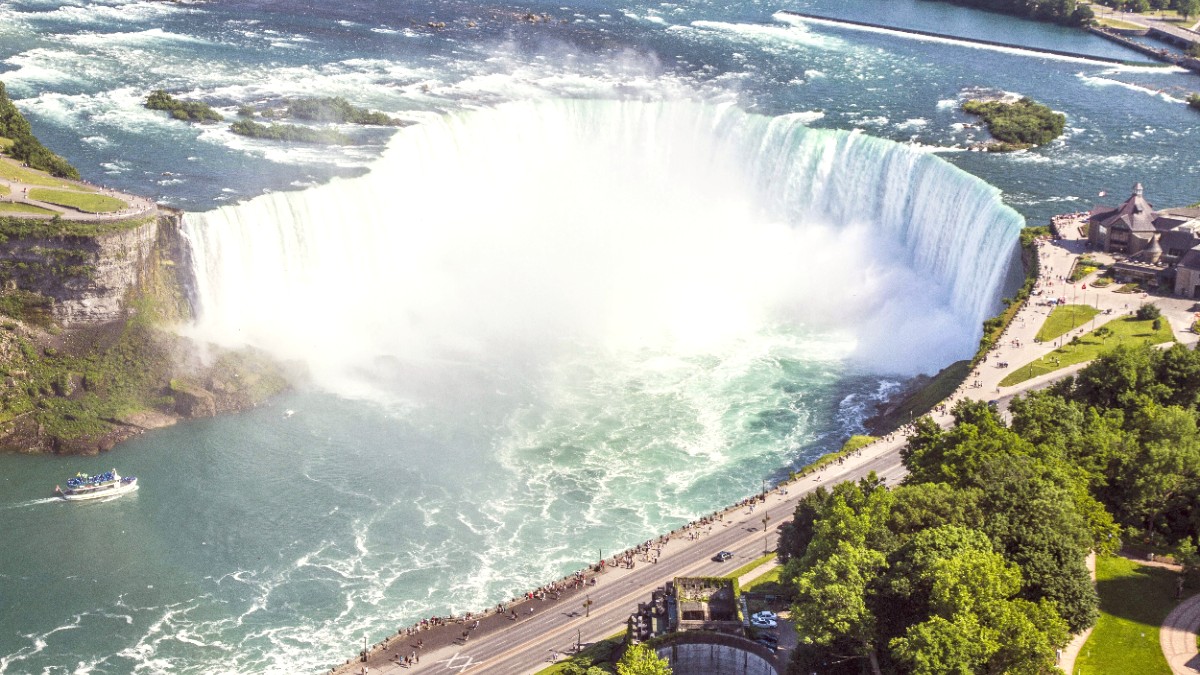
Ontario, Canada
Niagara Falls sits on the Niagara River, forming part of the border between Canada and the United States. The city of Niagara Falls, Ontario, on the Canadian side, faces Niagara Falls, New York, in the U.S. The Niagara River flows north from Lake Erie into Lake Ontario. This geographical position makes the Falls reachable from both countries, though the Canadian side generally presents the best panoramic vistas of all three waterfalls: the Horseshoe Falls (the largest, on the Canadian side), the American Falls, and the Bridal Veil Falls (both on the U.S. Side).
A drive along the Niagara Parkway is a scenic journey. It traces the Niagara River, presenting beautiful views and connecting many of the region's premier attractions.
This picturesque route offers a leisurely way to see the various natural and historical points of interest outside the immediate Falls area.
The story of Niagara Falls spans millennia, starting with its geological genesis. The Falls formed at the conclusion of the last Ice Age, approximately 12,500 years ago, as glacial meltwater carved a path through the Niagara Escarpment. The enduring erosion by the mighty flow of the Niagara River continues to shape the Falls, gradually moving them upstream over time. This ongoing geological event illustrates earth's dynamic forces. They revered the Falls as a sacred place, a source of power and sustenance. Their deep connection to the land and water defined their way of life around this natural wonder. Evidence of their settlements and customs continues to be found throughout the area.
European exploration brought the Falls to international recognition in the 17th century, with Father Louis Hennepin, a French explorer, providing one of the earliest documented European descriptions in 1678. His accounts introduced the Falls to the Western world. Numerous battles transpired in the area, shaping the current border and contributing to Canada's identity. Sites like Old Fort Erie and the Lundy's Lane Battlefield safeguard this military history, offering tangible links to a formative era.
Glacial meltwater shapes the Niagara Escarpment, forming the Falls.
Father Louis Hennepin's 1678 descriptions introduce the Falls to Europe.
Region features prominently in battles, shaping the Canada-U.S. Border.
Niagara Falls becomes a premier tourist destination; daredevils attract global attention.
The Niagara Parks Commission forms, safeguarding the Falls' natural beauty.
By the 19th century, Niagara Falls earned acclaim as a top tourist destination. Early daredevils attempting to conquer the Falls in barrels and on tightropes further fueled its mystique, though such activities are now illegal. The advent of railways made the Falls more accessible, leading to the construction of hotels, observation towers, and attractions. Nikola Tesla's pioneering work in hydroelectric power at Niagara Falls in the late 19th century further established its global importance, demonstrating how the Falls' raw energy could light up cities.
The Niagara Parks Commission, established in 1885, safeguards the natural and historical integrity of the Canadian side of the Falls. This commission ensures the area remains a public trust, preserving its beauty for future generations. This commitment to preservation allows visitors to experience the Falls in a protected, natural setting, while also enjoying modern attractions.
The Falls gained further prominence through Nikola Tesla's groundbreaking work in hydroelectric power generation. This innovation transformed the Falls from purely a natural wonder into a source of clean energy, fueling urban and industrial growth. It is a testament to human ingenuity harnessing natural forces.
Each layer of its past enriches the experience of this enduring natural wonder.
Niagara Falls, Ontario, delivers a blend of natural spectacle and energetic entertainment. The heart of any visit centers on the magnificent Horseshoe Falls, where visitors experience the mist and thunder firsthand. Boat tours take you to the base of the cascades, while tunnels permit you to stand behind the roaring water. Views from the Niagara Parkway offer sweeping splendor.
Beyond the Falls, the city provides a range of activities. Clifton Hill offers family-friendly attractions, including arcades, museums, and the iconic Niagara SkyWheel. Casinos present adult entertainment with gaming, live shows, and fine dining. The Niagara Parks system extends along the river, providing beautiful gardens, historical sites, and walking trails that offer quieter moments of contemplation amidst nature.
Scenic views and access to numerous natural and historical sites along the Niagara River.
Family entertainment with arcades, museums, and the famous Niagara SkyWheel.
World-class wineries and gourmet dining a short drive from the Falls.
The surrounding region complements the Falls experience. Niagara-on-the-Lake, a short drive away, captivates visitors with its historic streets, boutique shops, and a renowned theatre festival. The Niagara Wine Region, a short distance from the Falls, features world-class wineries, many with tasting rooms and gourmet restaurants. This creates a delightful contrast to the busy Falls area, offering relaxation and culinary exploration.
Over 20 million tourists visit Niagara Falls annually, making it a major attraction.
June to August observe the highest visitor numbers, with all attractions fully operating.
November to March present fewer visitors and unique winter experiences like light festivals.
Upscale restaurants with Falls views, offering international cuisine and local specialties.
Diners, cafes, and family-friendly restaurants abound, serving a variety of comfort foods.
Experience Niagara's renowned wines, ice wines, and fresh farm-to-table produce from the fertile region.